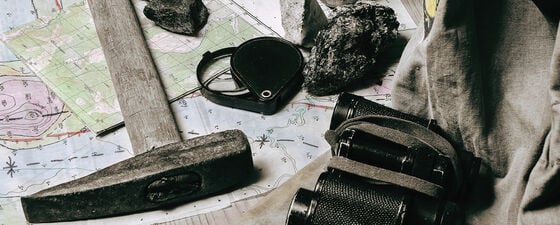Few of us today are fortunate enough to have had careers as field geologists (see GEO ExPro Vol. 19, No. 1, page 72), but almost all geologists will have undertaken fieldwork and mapping as a key part of their training and will know that hammers are a necessity. Specially manufactured for breaking or picking at rock in a variety of ways, whether using the hammer to expose fresh rock surfaces or to extract samples for further analysis, they are of critical importance to the geologist.

All geological hammers come with at least one flat face which is primarily for breaking rock where less accuracy is required or to break down larger pieces into smaller fragments. Most modern hammers will also have a pointed tip or pick at one end for more accurate, delicate work or extraction of crystals, clasts, or fossils. A chisel end comes in handy when prying apart layers. Hammers vary in two key respects: the head, and the forging. The head’s weight is an important consideration – 16 oz (453g) is suitable for almost all everyday use but someone with an interest in metamorphic rocks, or minerals, may prefer a larger head. Casual users may favour something lighter, though these are increasingly hard to source. Light hammers will suffice for most sediments and are therefore handy for fossil hunters – but will be less effective when confronted with a granite or marble.
The Forging is Key
The crème de la crème is a one-piece drop forged hammer, such as those manufactured by Estwing. These are made of one piece of metal and less prone to fracturing! A solid or tubular shaft hammer comprises a separate handle and head, joined together – this joint provides a point of weakness which may eventually fail. Most hammers should last for a long time before this becomes an issue, but as failure is often unpredictable, it may cause a hazard. A tubular shaft is hollow, and thus lighter, and it also allows the hammer to be better weighted; a solid shaft is more durable.

A wooden-shaft hammer has the shortest life, even if extreme care is taken when hammering, since the wood always tends to strike rock at some point, causing the handle to wear and splinter. However, you can at least see when the time is coming to replace the implement! The length of the handle is a consideration for some – extra-long handles being available, allowing a more powerful blow, and greater distance to be maintained from the rock – protecting the user from rock ‘shrapnel’. This leads me nicely to the safety warning. To avoid the danger of fragments of rock hitting you in the eyes, it’s advisable to always wear goggles when hammering – especially when hitting harder rocks. As always, common sense should always prevail!
Pride and Joy
I am the lucky owner of an Estwing special edition E30SE, given to me as a birthday present by my wife after she had clearly become fed up with me bemoaning the fate of my old student hammer (left on a coach on an Easter field trip to Spain in 1982!).

This relative newcomer is a 22 oz (624g) ‘head and pick’ hammer forged from a single piece of steel, designed to reduce impact shock and limit the risk of breakage. It has a lovely lacquered, bound leather grip and I am ashamed to admit, has so far only been used for fossil hunting on the Jurassic Coast of southern England. It does, however, take centre stage in my office and reminds me that the best geologists are the ones that have seen (and chipped away at) the most rocks.

